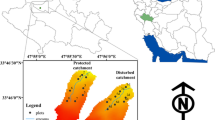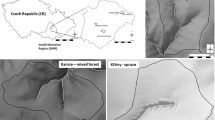Abstract
Ecosystem functions in forests can vary significantly after disturbance, depending on changes in vegetation structure during succession and soil biophysical characteristics. We examined streamflow regulation, water storage and soil protection functions in small catchments covered by evergreen temperate rain forests, developed over volcanic ash soils, in southern South America. Our aims were to understand the differences in ecosystem functioning among catchments representing different forest stages following human disturbance, from scrubland to old-growth forest condition. In these catchments (n = 3 per condition), we assessed and compared eco-hydrological functions over 21 months. In old-growth (OG) forest catchments, streamflow for the entire study period averaged 2102 ± 110 mm, followed by secondary forest (SF) catchments with an average of 1770 ± 284 mm and finally scrub catchments (CH) with 1684 ± 267 mm. Evapotranspiration showed higher values in SF catchments (643 mm), followed by CH catchments (612 mm) and OG catchments (346 mm). OG and CH catchments had the lowest sediment export in streamflow, without statistical difference between them, while SF catchments had the highest sediment concentrations in all seasons of the year. Principal component analysis revealed that soil physical properties, vegetation structure and catchment morphometry were all relevant to explain the differences among the three forest successional stages compared. We validate the hypotheses that streamflow regulation and soil water storage capacity are greatly enhanced in old-growth forests, while the soil protection function is maximized in both early (bamboo-dominated) and advanced forest stages.




Similar content being viewed by others
References
Anderson M. 2017. Permutational Multivariate Analysis of Variance (PERMANOVA). Balakrishnan N, Colton T, Everitt B, Piegorsch W, Ruggeri F, Teugels JL, Eds. Wiley StatsRef: Statistics Reference Online. https://doi.org/10.1002/9781118445112.stat07841.
Aravena J, Carmona M, Pérez C, Armesto JJ. 2002. Changes in tree species richness, stand structure and soil properties in a successional chronosequence in northern Chiloé Island, Chile. Revista Chilena de Historia Natural 75:339–60.
Burt TP, McDonnell JJ. 2015. Whither field hydrology? The need for discovery science and outrageous hydrological hypotheses. Water Resource Research 51:5919–28.
Cuevas J, Arumí J, Dörner J. 2019. Assessing methods for the estimation of response times of stream discharge: the role of rainfall duration. Journal of Hydrology and Hydromechanics 67:143–53.
Dec D, Zúniga F, Thiers O, Paulino L, Valle S, Villagra V, Tadich I, Horn R, Dörner J. 2017. Water and temperature dynamics of Aquands under different uses in southern Chile. Journal of Soil Science and Plant Nutrition 17(1):141–54.
Di Castri F, Hajek E, Eds. 1976. Bioclimatología de Chile. Santiago: Vicerrectoría de comunicaciones, Universidad Católica de Chile.
Donoso P, Frêne C, Flores M, Moorman M, Oyarzún C, Zavaleta J. 2014. Balancing water supply and old-growth forest conservation in the lowlands of south-central Chile through adaptive co-management. Landscape Ecology 29:245–60.
Dörner J, Dec D, Peng X, Horn R. 2010. Effect of land use change on the dynamic behaviour of structural properties of an Andisol in southern Chile under saturated and unsaturated hydraulic conditions. Geoderma 159:189–97.
Dörner J, Huertas J, Cuevas JG, Leiva C, Paulino L, Arumí J. 2015. Water content dynamics in a volcanic ash soil slope in southern Chile. Journal of Plant Nutrition and Soil Science 178:693–702.
Dörner J, Dec D, Zúñiga F, Horn R, López I, Leiva C, Cuevas JG. 2013. Soil changes in the physical quality of an Andosol under different management intensities in Southern Chile. In: Krümmelbein J, Horn R, Pagliai M, Eds. Soil degradation. Advances in Geoecology, Vol. 42. Reiskirchen: Catena Verlag GMBH. p 262–81.
Ellies A, Grez R, Ramírez C. 1997. La conductividad hidráulica en fase saturada como herramienta para el diagnóstico de la estructura del suelo. Agro Sur 25(1):51–6.
Ellies A, Ramírez C, Mac Donald R. 2003. Wetting capacity in aggregates from soils with a different management. Food, Agriculture and Environment 1:229–33.
Feller M. 1981. Water balance in Eucalyptus regnans, E. obliqua and Pinus radiata forests in Victoria. Australia Forestry 44(3):153–61.
Fischer A, Marshall P, Camp A. 2013. Disturbances in deciduous temperate forest ecosystems of the northern hemisphere: their effects on both recent and future forest development. Biodiversity Conservation 22:1863–93.
Franklin J, Spies T, Van Pelt R, Carey A, Thornburgh D, Berg D, Lindenmayer D, Harmon M, Keeton W, Shaw D, Bible K, Chen J. 2002. Disturbances and structural development of natural forest ecosystems with silvicultural implications, using Douglas-fir forests as an example. Forest Ecology and Management 155:399-423.
Geißler C, Nadrowski K, Kühn P, Baruffol M, Bruelheide H, Schmid B, Scholten T. 2013. Kinetic energy of throughfall in subtropical forests of SE China—effects of tree canopy structure, functional traits, and biodiversity. PLoS ONE 8(2):e49618. https://doi.org/10.1371/journal.pone.0049618.
Gericke O, Smithers J. 2014. Review of methods used to estimate catchment response time for the purpose of peak discharge estimation. Hydrological Sciences Journal 59(11):1935–71.
Gilliam F. 2016. Forest ecosystems of temperate climatic regions: from ancient use to climate change. New Phytologist 212:871–87.
Godoy R, Valenzuela E, Guevara G, Boy J, Barrientos M, Matus F. 2014. Biogeoquímica en bosques templados del sur de Chile. In: Donoso C, González M, Lara A, Eds. Ecología Forestal: bases para el manejo sustentable y conservación de los bosques nativos de Chile. Valdivia: Ediciones UACH. p 257–80.
Gorham E, Vitousek P, Reiners W. 1979. The regulation of chemical budgets over the course of terrestrial ecosystem succession. Annual Review of Ecology and Systematics 10:53–84.
Halfmann D. 2005. Management system effects on water infiltration and soil physical properties. Thesis Master of Science. Lubbock: Texas Tech University.
Hallet P, Young I. 1999. Changes to water repellence of soil aggregates caused by substrate-induced microbial activity. European Journal of Soil Science 50:35–40.
Hedin L, Campos H. 1991. Importance of small streams in understanding and comparing watershed ecosystem processes. Revista Chilena Historia Natural 64:583–96.
Hedin L, Armesto JJ, Johnson A. 1995. Patterns of nutrient loss from unpolluted, old-growth forests: evaluation of biogeochemical theory. Ecology 76:493–509.
Lara A, Amoroso M, Bannister J, Donoso C, Gonzalez M, Vargas R, Smith-Ramírez C, Arellano G, Gutierrez A. 2014. Sucesión y Dinámica de Bosques Templados en Chile. In: Donoso C, González M, Lara A, Eds. Ecología Forestal: Bases para el Manejo Sustentable y Conservación de los Bosques Nativos de Chile. pp 323–410.
Levia D, Carlyle-Moses D, Tanaka T, Eds. 2011. Forest hydrology and biogeochemistry: synthesis of past research and future directions. Berlin: Springer.
Lienard J, Florescu I, Strigul N. 2015. An appraisal of the classic forest succession paradigm with the shade tolerance index. PLoS ONE 10(2):e0117138. https://doi.org/10.1371/journal.pone.0117138.
Likens G. 2001. Biogeochemistry, the watershed approach: some uses and limitations. Marine and Freshwater Resources 52:5–12.
Likens G. 2004. Some perspectives on long-term biogeochemical research from the Hubbard Brook Ecosystem Study. Ecology 85(9):2355–62.
Likens G, Bormann F. 1995. Biogeochemistry of a forested ecosystem. 2nd edn. New York: Springer.
Margalef R. 1963. On certain unifying principles in ecology. The American Naturalist 97:357–74.
McDonnell J. 2013. Are all runoff processes the same? Hydrological Processes 27:4103–11.
McWethy D, Higuera P, Whitlock C, Veblen T, Bowman D, Cary G, Haberle S, Keane R, Maxwell B, McGlone M, Perry G, Wilmshurst J, Holz A, Tepley A. 2013. A conceptual framework for predicting temperate ecosystem sensitivity to human impacts on fire regimes. Global Ecology and Biogeography 22:900–12.
Miura S, Hirai K, Yamada T. 2002. Transport rates of surface materials on steep forested slopes induced by raindrop splash erosion. Journal of Forest Research 7:201–11.
Nippgen F, McGlynn B, Emanuel R. 2015. The spatial and temporal evolution of contributing areas. Water Resource Research 51:4550–73.
Nolan C, Overpeck J, Allen J, Anderson P, Betancourt J, Binney H, Brewer S, Bush M, Chase B, Cheddadi R, Djamali M, Dodson J, Edwards M, Gosling W, Haberle S, Hotchkiss S, Huntley B, Ivory S, Kershaw A, Kim S, Latorre C, Leydet M, Lézine A, Jackson S. 2018. Past and future global transformation of terrestrial ecosystems under climate change. Science 361:920–23.
Odum E. 1969. The strategy of ecosystem development. Science 164:262–70.
Ohte N, Tokuchi N. 2011. Forest hydrology and biogeochemistry by ecoregion, chapter VIII. Temperate region. In: Levia DF, Carlyle-Moses D, Tanaka T, Eds. Forest hydrology and biogeochemistry: synthesis of research and future directions. New York: Springer. p 261–84.
Oyarzún C, Frêne C, Lacrampe G, Huber A, Hervé P. 2011. Soil hydrologic properties and sediment transport in two headwater catchments with different vegetative cover. Bosque 32(1):10–19.
Parfitt R, Wilson A. 1985. Estimation of allophane and halloysite in three sequences of volcanic soils, New Zealand. In: Caldas EF, Yaalon DH, Eds. Volcanic soils, weathering and landscape relationships of soils on tephra and basalt. West Germany :Verlag. Catena Supplement 7, pp 1–8.
Perakis S, Hedin L. 2002. Nitrogen loss from unpolluted South American forests mainly via dissolved organic compounds. Nature 415:416–19.
Perroux K, White I. 1988. Designs for disc permeameters. Soil Science Society of America Journal 52:1205–15.
Sadzawka A, Carrasco M, Grez R, Mora M, Flores H, Neaman A. 2006. Métodos de análisis recomendados para los suelos de Chile. Revisión 2006. Santiago: Serie Actas INIA Nº 34, Instituto de Investigaciones Agropecuarias.
Sandoval M, Dörner J, Seguel O, Cuevas J, Rivera D. 2012. Métodos de Análisis Físicos de Suelos. Universidad de Concepción. Publicaciones Departamento de Suelos y Recursos Naturales, número 5. Chillán, Chile.
Schlatter J, Gerding V. 1995. Métodos de clasificación de sitios para la producción forestal, ejemplo en Chile. Bosque 16(2):13–20.
Swank W, Crossley D Jr, Eds. 1988. Forest hydrology and ecology at Coweeta. Ecological studies, Vol. 66. New York: Springer.
Témez J. 1978. Cálculo hidrometeorológico de caudales máximos en pequeñas cuencas naturales. Madrid: Ministerio de Obras Públicas y Urbanismo (MOPU), Dirección General de Carreteras.
Tsukamoto J. 1989. Movement of soil and litter down slopes in three types of forests (I) movement of soil having particles less than two millimeters in diameter. Journal of Japanese Forest Society 71:469–80.
Veblen T, Donoso C, Schlegel F, Escobar B. 1981. Forest dynamics in south-central Chile. Journal of Biogeography 8(3):211–47.
Vitousek P, Reiners W. 1975. Ecosystem succession and nutrient retention: a hypothesis. Bioscience 25(6):376–81.
Ward A, Trimble S. 2004. Environmental hydrology. New York: Lewis Publishers CRC Press Company.
Zúñiga F, Dec D, Valle SR, Dörner J. 2016. Anisotropía de las propiedades hidráulicas de un Andisol del Sur de Chile. Agro Sur 44(1):79–86.
Acknowledgements
CF was supported by Becas CONICYT de Doctorado Nacional and by the Institute of Ecology and Biodiversity (IEB-Chile). He acknowledges the advice and support of Achim Ellies Lab, Faculty of Agricultural Sciences, and Sedimentology Lab, Faculty of Sciences, both from Universidad Austral de Chile. FDA was supported by FONDECYT 1170995. The field study was supported by grants ICM-MINECON, P05-002 and CONICYT PFB-0023 (Chile) to the Institute of Ecology and Biodiversity.
Author information
Authors and Affiliations
Corresponding author
Additional information
Author's Contribution
CF conceived and designed study, performed research, analyzed data and wrote the paper. JD and FZ designed study, performed research, analyzed data, contributed new methods and wrote the paper. JGC analyzed data, contributed new methods and wrote the paper. FDA analyzed data and contributed new methods. JJA conceived study, contributed new models and wrote the paper.
Electronic supplementary material
Below is the link to the electronic supplementary material.
Rights and permissions
About this article
Cite this article
Frêne, C., Dörner, J., Zúñiga, F. et al. Eco-hydrological Functions in Forested Catchments of Southern Chile. Ecosystems 23, 307–323 (2020). https://doi.org/10.1007/s10021-019-00404-7
Received:
Accepted:
Published:
Issue Date:
DOI: https://doi.org/10.1007/s10021-019-00404-7




